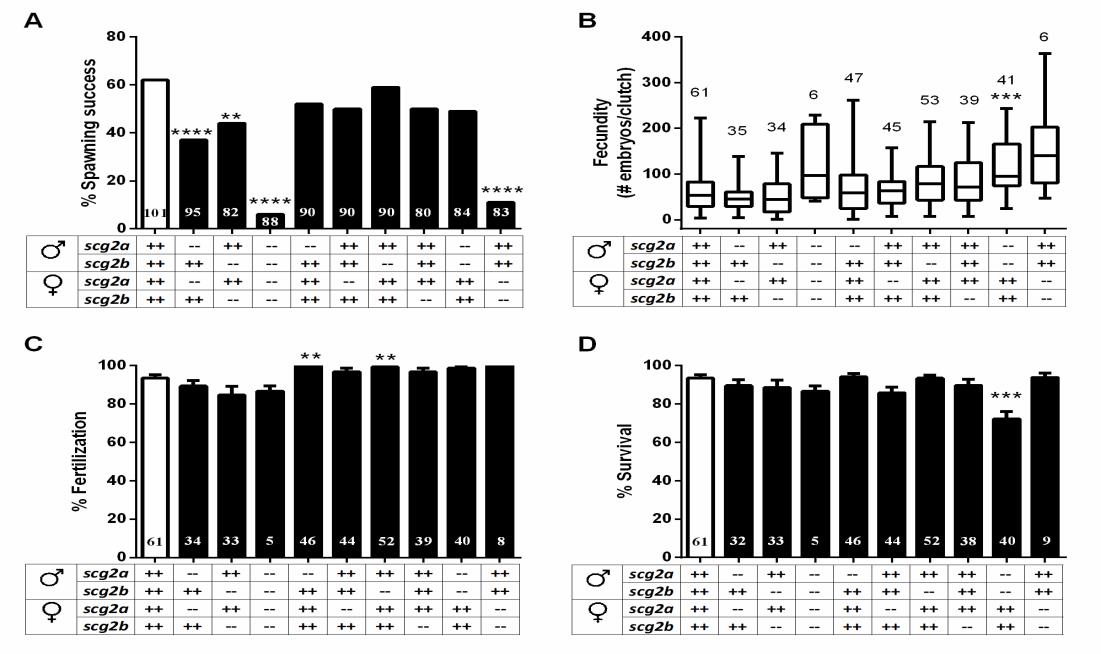Highlights
Chinese, Canadian Scientists Find New Sex Hormone in Fish
The secretory granule protein secretogranin-2 (Scg2) is mainly distributed in dense-core vesicles of many neurons and endocrine cells and is overexpressed in some human neuroendocrine tumors. Secretoneurin (SN) is a neuropeptide derived from specific proteolytic processing of Scg2. It was previously reported that synthetic SN stimulates luteinizing hormone (Lh) release in vivo and from dispersed goldfish pituitary cells in vitro, indicating SN as a new hormone may play a critical stimulatory role in vertebrate reproduction. However, its role in hormonal control of reproduction is unknown.
Recently, researchers from Institute of Hydrobiology (IHB) of Chinese Academy of Sciences, cooperating with Prof. Vance L. Trudeau’s team from University of Ottawa, used scg2 mutant zebrafish models to reveal the critical role scg2 plays in sexual behavior and reproduction. This study was recently published online in PNAS.
With comprehensive quantitative video analysis, researchers observed five male courtship behaviors in both wild type (WT) and scg2a-/-; scg2b-/- mutant spawning trials. Significant reductions in the duration of chase, tailnose, encircle, and quiver behaviors, were observed in mutant lines as compared to WT withinline crosses, indicating that scg2a-/-; scg2b-/- mutation reduces all stereotypical male courtship behaviors.
Within-line crossing revealed that spawning success was significantly reduced to 37% (P = 0.0006), 44% (P = 0.0169), and 6% (P < 0.0001) in scg2a?/?, scg2b?/?, and scg2a?/?;scg2b?/? fish, respectively, relative to the 62% success rate in WT fish. Additional within-line breeding trials indicated that spawning success can be improved with SN treatments.
The mRNA levels for gonadotropin-releasing hormone (gnrh3) in the hypothalamus, Lh subunit b (lhb) and glycoprotein alpha (cga) in the pituitary were quantified with droplet digital PCR (ddPCR). Researchers found significant reductions in the expression of gnrh3 in the hypothalamus, lhb and cga in the pituitary, suggesting that Scg2 or Scg2-derived peptides drive the Gnrh-Lh control system. Moreover, injection with the Lh agonist human chorionic gonadotropin improved spawning success in the scg2a-/-; scg2b-/- fish.
The study supports the hypothesis that secretogranin-2 is a reproductive hormone and offers an amenable model system in which to screen potential injectable stimulators of reproduction, be they for improved spawning in cultured fish species, or to help with the search for new human infertility treatments.
Kimberly Mitchell (PhD student) from the University of Ottawa is the first author of the paper. TAO Binbin (PhD) and CHEN Lu (master student) from Fish Genetic Engineering Research Group of IHB participated in the research. Prof. HU Wei and Prof. Vance L. Trudeau are co-corresponding authors of the paper.
This work was supported by the International Partnership Program of Chinese Academy of Science, the innovative research group of National Natural Science Foundation of China, and the University of Ottawa International Research Acceleration Program.

Spawning success, fecundity, fertilization, and survival of embryos produced during zebrafish pairwise matings. (A) Percent of spawning success of within-line and reciprocal crosses. Significant differences were determined using Fisher’s exact test. (B) Box plots of the number of embryos produced per couple. Horizontal lines represent median values; boxes represent interquartile ranges and whiskers represent minimum–maximum values. P values present the comparison of that group against the wild-type pair using Kruskal–Wallis and Dunn’s test for post hoc comparisons. (C) Mean (+SEM) % fertilization and (D) % embryo survival of mating crosses. Since the data were not normally distributed, significant differences were determined using a Kruskal–Wallis test on ranks followed by a Dunn’s multiple comparison test. Sample sizes (n) are indicated in or above each bar for that group. Asterisks denote a significant difference from the wild-type within line cross (white bar); ****P ≤ 0.0001; ***P ≤ 0.001; **P ≤ 0.01. (Image by IHB & uOttawa)